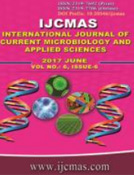


 National Academy of Agricultural Sciences (NAAS)
National Academy of Agricultural Sciences (NAAS)

|
PRINT ISSN : 2319-7692
Online ISSN : 2319-7706 Issues : 12 per year Publisher : Excellent Publishers Email : editorijcmas@gmail.com / submit@ijcmas.com Editor-in-chief: Dr.M.Prakash Index Copernicus ICV 2018: 95.39 NAAS RATING 2020: 5.38 |
An extremely haloalkaliphilic archaeon, Natrialba sp. SSL1, gram-negative, rod-shaped, motile, aerobic, chemoorganotrophic belonging to the family Halobacteriaceae within the Phylum Euryarchaeota was isolated from Sambhar Salt Lake (SSL), Rajasthan, India in the 1980s. The Whole Genome Sequence (WGS) of this archaeon was deciphered for the purpose of comparative genomics with other halobacteria as well as eubacteria. The WGS raw data of the genome was assembled into 61 contigs, showing total sequence length of 4,580,837bp, comprising of 4276 genes, out of which 4126 were found to be coding genes (exons), while 96 were psuedogenes. It encodes for 4048 proteins, some of which are peptide repeats of various lengths. Comparative genomic analysis facilitated the identification of genes encoding proteins involved in glycosylation, synthesis of novel archaeal isoprenoid glycolipid identified as glucopyranosyl-1, 6-glucopyranosyl-1-glycerol diether (DGD-4), bacteriocin (halocin), adaptation to salinity stress response, etc. Based on genomic analysis, Natrialba sp. SSL1is metabolically versatile and can grow on various carbon and nitrogen sources. Presence of photosystem reaction centre subunit H indicates parallel photosynthetic proton generation system. Genes annotation revealed the presence of extremozymes like alpha-amylase, lipase, protease, trehalose phosphatase, etc. that can be exploited further for biotechnological purpose. This is the first haloalkaliphilic archaeal genome sequenced from India.
 |
 |
 |
 |
 |